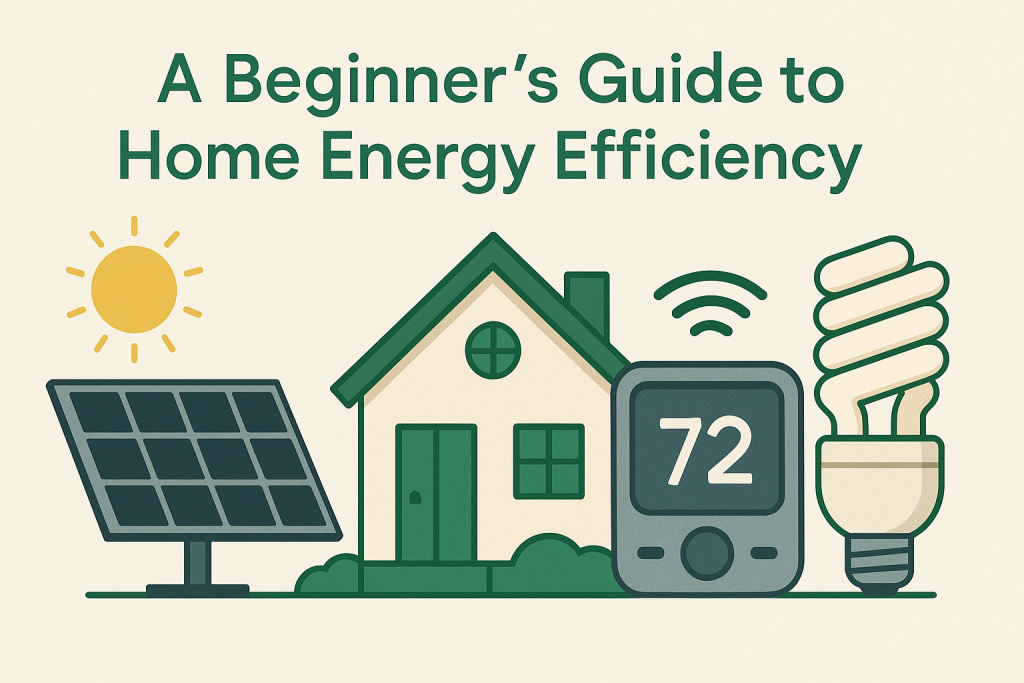As energy costs continue to rise and environmental concerns become more pressing, homeowners are increasingly seeking practical ways to improve home energy efficiency. This guide introduces a beginner-friendly approach, highlighting emerging trends and technologies that make energy savings more accessible and manageable for everyone.

Why Home Energy Efficiency Matters
Home energy efficiency reduces utility bills, minimizes your carbon footprint, and enhances overall comfort. According to the U.S. Energy Information Administration, residential energy use accounts for about 21% of total U.S. energy consumption. Improving how efficiently we use energy at home plays a vital role in long-term sustainability.
Getting Started with Home Energy Efficiency
If you’re new to the idea, the first step is understanding where your home stands. Begin by:
- Conducting an Energy Audit
- Many utility companies offer free or discounted audits.
- Professionals assess insulation, HVAC efficiency, lighting, and appliance performance.
- Understanding Your Energy Bill
- Look for usage spikes.
- Compare month-to-month and season-to-season patterns.
Trend: Smart Home Energy Monitoring Devices
Modern homes benefit from real-time energy monitoring tools. Devices like Sense, Emporia, and Wiser Energy allow users to track energy consumption down to individual appliances, providing actionable insights.
Benefits:
- Pinpoint inefficient devices.
- Get daily and monthly usage reports.
- Reduce waste by making data-informed adjustments.
Low-Cost Improvements with High Impact
For beginners, it helps to start with changes that require minimal investment but offer noticeable results:
- Switch to LED bulbs: Use 75% less energy and last 25 times longer than incandescent.
- Seal windows and doors: Prevent air leaks with weather stripping and caulking.
- Adjust thermostat settings: Lowering it by just 1°C can cut heating bills by up to 10%.
- Install faucet aerators and low-flow showerheads: Reduce water heating needs.
Trend: Smart Thermostats and Automation
Smart thermostats such as the Nest Learning Thermostat or Ecobee learn your habits and adjust temperatures accordingly. According to a study by Nest, these devices can save 10-12% on heating and 15% on cooling.
Tips for usage:
- Set temperature schedules.
- Use geofencing for automatic adjustments.
- Monitor HVAC runtime and efficiency.
Insulation and Ventilation Basics
Proper insulation reduces the workload on your heating and cooling systems. Focus on:
- Attic insulation: A top source of heat loss.
- Wall and floor insulation: Crucial in older homes.
- Ventilation: Ensure fresh air flow to prevent moisture and improve indoor air quality.
Appliances: Upgrade Wisely
Older appliances often consume more energy. If your budget allows, prioritize:
- Refrigerators (pre-2001 models)
- Top-load washing machines
- Electric water heaters
Look for ENERGY STAR ratings, which indicate superior efficiency performance.
Trend: Home Solar Panels for Beginners
The cost of solar panel installation has dropped by over 50% in the past decade. Federal incentives and state rebates make solar more viable for entry-level adopters.
Considerations:
- Start with a smaller system to offset partial usage.
- Use net metering programs to sell unused energy back to the grid.
- Explore community solar programs if home installation isn’t feasible.
Behavior Changes That Add Up
Energy efficiency isn’t just about devices—habits matter too.
- Turn off lights when not in use.
- Unplug electronics or use smart plugs.
- Wash clothes in cold water.
- Dry clothes on a line when possible.
- Run dishwashers and washing machines only with full loads.
Making a Plan: Small Steps Toward Efficiency
Here’s a beginner’s action checklist:
- Schedule an energy audit.
- Install energy monitors or smart plugs.
- Swap out light bulbs for LEDs.
- Seal leaks around doors and windows.
- Adjust water heater to 120°F (49°C).
- Program thermostat based on daily routines.
- Research local solar incentives.
Keyphrase Highlight: Home Energy Efficiency
Improving home energy efficiency doesn’t require a massive overhaul. With modern tech, low-cost upgrades, and mindful usage, any homeowner can make progress. Whether you’re automating your thermostat or just sealing a drafty window, every action contributes to reduced energy use and long-term savings.
References:
- U.S. Energy Information Administration. (2023). “Use of energy explained.” https://www.eia.gov/energyexplained/
- ENERGY STAR. (2024). “Energy-efficient products.” https://www.energystar.gov/products
- Nest Thermostat Savings Report. (2023). https://nest.com/thermostats/real-savings/
- Office of Energy Efficiency & Renewable Energy. (2024). “Insulation and air sealing.” https://www.energy.gov/eere






